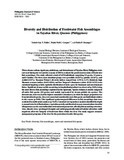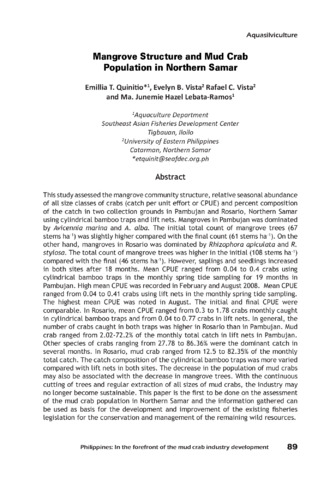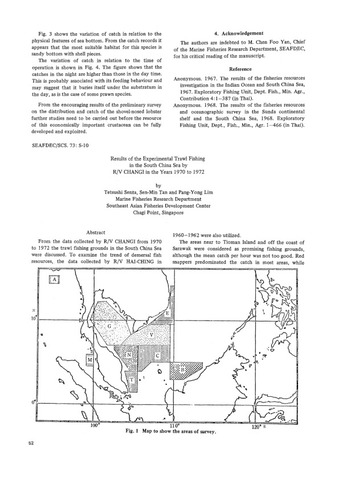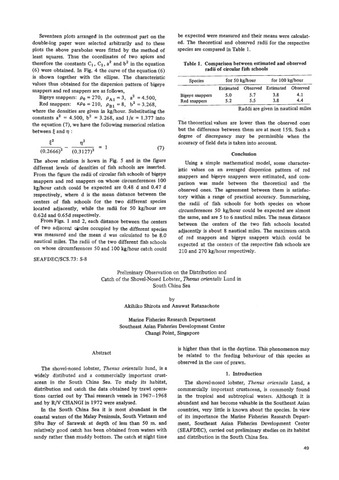Diversity and distribution of freshwater fish assemblages in Tayabas River, Quezon (Philippines)
Share
Abstract
Three stream sections (upstream, midstream, and downstream) of Tayabas River, Philippines were surveyed during the wet and dry seasons of 2010 to evaluate the poorly known status of freshwater fish assemblages. The study collected a total of 1,070 individuals comprising 15 species, 13 genera, and 8 families. The three most abundant groups were poeciliids (61.85%), gobiids (26.16%), and cichlid (5.51%). Shannon-Weiner’s diversity indices ranged from 1.270 to 2.171. Relatively high Shannon evenness indices (0.653–0.846) and low Simpson’s dominance values (0.142–0.322) were calculated implying a fairly equitable distribution of niche space for dominant and non-dominant fishes. Significant change on fish assemblage in longitudinal gradient was observed (p<0.05), being the most diverse fish assemblage registered in the upstream. Species richness is mostly composed of native fish species (10 species) and mainly represented by stream gobiids (six species). The downstream, however, had the highest cumulative abundance, in which the larger proportion was from introduced species. Also, wet season had considerably more fish species and individuals relative to dry season (p<0.05). This significant spatio-temporal differences in fish assemblage data were evaluated by multivariate analyses (p<0.05). Canonical correspondence analysis identified the depth (seasonal water level fluctuations), vegetation growth, and dissolved oxygen concentrations (in order of importance) as the most influential environmental parameters affecting fish assemblage structure. Also, climatic stress (prolonged drought) and anthropogenically-induced habitat alteration could negatively affect the integrity of freshwater fishes within the river. The study suggests extensive management programs of the river for the protection of native fish species.
Suggested Citation
Paller, V. G. V., Corpuz, M. N. C., & Ocampo, P. P. (). Diversity and distribution of freshwater fish assemblages in Tayabas River, Quezon (Philippines). Philippine Journal of Science , 142(1), 55-67. http://hdl.handle.net/10862/2236
Subject
Collections
- AQD Journal Articles [1215]
Related items
Showing items related by title, author, creator and subject.
-
Mangrove structure and mud crab population in northern Samar
Quinitio, Emilia T.; Vista, Evelyn B.; Vista, Rafael C.; Lebata-Ramos, Ma. Junemie Hazel (Aquaculture Department, Southeast Asian Fisheries Development Center, 2017)This study assessed the mangrove community structure, relative seasonal abundance of all size classes of crabs (catch per unit effort or CPUE) and percent composition of the catch in two collection grounds in Pambujan and ... -
Results of the experimental trawl fishing in the South China Sea by R/V Changi in the years 1970 to 1972
Senta, Tetsushi; Tan, Sen-Min; Lim, Pang-Yong (Japan International Cooperation Agency, 1977)From the data collected by R/V CHANGI from 1970 to 1972 the trawl fishing grounds in the South China Sea were discussed. To examine the trend of demersal fish resources, the data collected by R/V HAI-CHING in 1960 – 1962 ... -
Preliminary observation on the distribution and catch of the shovel-nosed lobster, Thenus orientalis Lund in South China Sea
Shirota, Akihiko; Ratanachote, Anuwat (Japan International Cooperation Agency, 1977)The shovel-nosed lobster, Thenus orientalis lund, is a widely distributed and a commercially important crustacean in the South China Sea. To study its habitat, distribution and catch the data obtained by trawl operations ...





